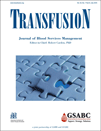Design of a donor-driven data collection strategy for operational improvement of blood donation process
Abstract
BACKGROUND: Prior studies have noted that donor retention may be negatively impacted by the total time it takes to complete the blood donation process.
STUDY DESIGN AND METHODS: To gain a comprehensive understanding of the blood donation process and examine opportunities for operational improvements, an educational partnership established between a blood bank and a university designed and implemented a donor-driven data collection strategy.
RESULTS: A large amount of real-time, comprehensive, donor-reported data was collected as donors navigated the process, which has enabled a thorough analysis of the process and its potential improvements.
CONCLUSION: In this paper, we describe the design and implementation efforts, examine the challenges in operationalizing a donor-driven data collection approach, and present insights and recommendations for its application in similar settings.




